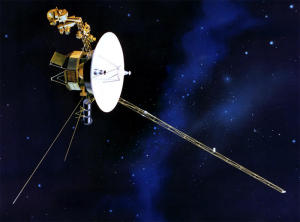
Voyager 1 appears to have at long last left our solar system and entered interstellar space, says a University of Maryland-led team of researchers.
 Carrying Earthly greetings on a gold plated phonograph record and still-operational scientific instruments -- including the Low Energy Charged Particle detector designed, built and overseen, in part, by UMD's Space Physics Group -- NASA's Voyager 1 has traveled farther from Earth than any other human-made object. And now, these researchers say, it has begun the first exploration of our galaxy beyond the Sun's influence.
Carrying Earthly greetings on a gold plated phonograph record and still-operational scientific instruments -- including the Low Energy Charged Particle detector designed, built and overseen, in part, by UMD's Space Physics Group -- NASA's Voyager 1 has traveled farther from Earth than any other human-made object. And now, these researchers say, it has begun the first exploration of our galaxy beyond the Sun's influence.
"It's a somewhat controversial view, but we think Voyager has finally left the Solar System, and is truly beginning its travels through the Milky Way," says UMD research scientist Marc Swisdak, lead author of a new paper published online this week in The Astrophysical Journal Letters. Swisdak and fellow plasma physicists James F. Drake, also of the University of Maryland, and Merav Opher of Boston University have constructed a model of the outer edge of the Solar System that fits recent observations, both expected and unexpected.
Their model indicates Voyager 1 actually entered interstellar space a little more than a year ago, a finding directly counter to recent papers by NASA and other scientists suggesting the spacecraft was still in a fuzzily-defined transition zone between the Sun's sphere of influence and the rest of the galaxy.
But why the controversy?
At issue is what the boundary-crossing should look like to Earth-bound observers 11 billion miles (18 billion kilometers) away. The Sun's envelope, known as the heliosphere, is relatively well-understood as the region of space dominated by the magnetic field and charged particles emanating from our star. The heliopause transition zone is both of unknown structure and location. According to conventional wisdom, we'll know we've passed through this mysterious boundary when we stop seeing solar particles and start seeing galactic particles, and we also detect a change in the prevailing direction of the local magnetic field.
NASA scientists recently reported that last summer, after eight years of travel through the outermost layer of the heliosphere, Voyager 1 recorded "multiple crossings of a boundary unlike anything previously observed." Successive dips in, and subsequent recovery of, solar particle counts caught researchers' attention. The dips in solar particle counts corresponded with abrupt increases in galactic electrons and protons. Within a month, solar particle counts disappeared, and only galactic particle counts remained. Yet Voyager 1 observed no change in the direction of the magnetic field.
To explain this unexpected observation, many scientists theorize that Voyager 1 has entered a "heliosheath depletion region," but that the probe is still within the confines of the heliosphere. Swisdak and colleagues, who are not part of the Voyager 1 mission science teams, say there is another explanation.
In previous work, Swisdak and Drake have focused on magnetic reconnection, or the breaking and reconfiguring of close and oppositely-directed magnetic field lines. It's the phenomenon suspected to lurk at the heart of solar flares, coronal mass ejections and many of the sun's other dramatic, high-energy events. The UMD researchers argue that magnetic reconnection is also key to understanding NASA's surprising data.
Though often depicted as a bubble encasing the heliosphere and its contents, the heliopause is not a surface neatly separating "outside" and "inside." In fact, Swisdak, Drake and Opher assert that the heliopause is both porous to certain particles and layered with complex magnetic structure. Here, magnetic reconnection produces a complex set of nested magnetic "islands," self-contained loops which spontaneously arise in a magnetic field due to a fundamental instability. Interstellar plasma can penetrate into the heliosphere along reconnected field lines, and galactic cosmic rays and solar particles mix vigorously.
Most interestingly, drops in solar particle counts and surges in galactic particle counts can occur across "slopes" in the magnetic field, which emanate from reconnection sites, while the magnetic field direction itself remains unchanged. This model explains observed phenomena from last summer, and Swisdak and his colleagues suggest that Voyager 1 actually crossed the heliopause on July 27, 2012.

 Previous page
Previous page Back to top
Back to top







